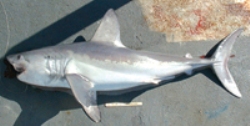Porbeagle Shark

Common Name: Porbeagle Shark
Scientific Name: Lamna nasus
Porbeagle Shark : Description
The Porbeagle was first validly described as Squalus nasus by Bonnaterre in 1788. Gunnerus had described it earlier in 1768 as Squalus glaucus, but this name was already in use for the blue shark, now Prionace glauca. The current valid name of this shark is Lamna nasus. The genus name Lamna is translated from Greek "lamna, -es" as a voracious fish while the species name nasus originates from Latin, meaning nose.
Porbeagle Shark : Habitat
Although the Porbeagle is predominantly pelagic (open-ocean), it can be found in both coastal and oceanic waters. The species occurs in both hemispheres and is found at water temperatures from 34o to 64oF (1o-18oC). It prefers cold water, but was once recorded in water of 73oF (23oC). It does not appear to enter freshwater, but has been caught in a brackish estuary of Argentina. It can be found at the surface to a depth of 2,346 ft (715 m).
Porbeagle Shark : Biology
The Porbeagle has a heavy spindle-shaped body with a moderately long conical snout. The gill slits are large. The caudal peduncle is strongly keeled, with short secondary keels on the caudal base. The caudal fin is crescent-shaped. The large first dorsal fin has a white free rear tip. The second dorsal and anal fins can pivot.The dorsal and lateral surfaces of the porbeagle are dark blue to gray in color. The first dorsal fin is dark with an abruptly white or gray free rear tip. The porbeagle has a maximum total length of about 12 ft (365 cm) and maximum weight of over 500 lbs (230 kg). Maximum age is likely about 30 years. There is considerable variation in estimates for size at maturity for this species.
Porbeagle Shark : Food
Porbeagles are opportunistic feeders. In the northwest Atlantic, their diet consists primarily (90%) of teleosts (bony fish). In the spring, these are mostly pelagic fish, like lancetfish, herring, sauries, and mackerels. In the fall, these are mostly groundfish, like sand lances, lumpsuckers, flounders, hakes, and cod. Cephalopods, like squid, are the second most common prey item.
Large males will often take on the most dangerous jobs when tackling potentially dangerous prey, but females appear to be responsible for teaching hunting techniques to their young.
Porbeagle Shark : Reproduction
In the Northern Hemisphere, porbeagles mate autumn-winter and give birth spring-summer. The little data that exists for the Southern Hemisphere populations indicates that they may be out of phase with those of the Northern Hemisphere, giving birth off New Zealand and Australia in winter.
During mating, the male shark bites the female shark to hold onto her while they copulate.Gestation is probably eight to nine months. Litters of 1-6 embryos have been recorded, but the usual number is 4, with 2 embryos per uterus. The porbeagle is ovoviviparous, meaning that it gives birth to live young, but in the uterus (womb), embryos have no placental or other direct connection to the mother.
 Deep Sea Crabs
Deep Sea Crabs